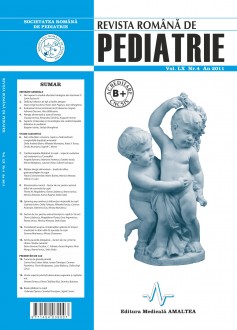SELECT ISSUE

Indexed

| |

|
|
|
| |
|
|
|

|
|
|
|
|
|
|
HIGHLIGHTS
National Awards “Science and Research”
NEW! RJP has announced the annually National Award for "Science and Research" for the best scientific articles published throughout the year in the official journal.
Read the Recommendations for the Conduct, Reporting, Editing, and Publication of Scholarly work in Medical Journals.
The published medical research literature is a global public good. Medical journal editors have a social responsibility to promote global health by publishing, whenever possible, research that furthers health worldwide.
Dilated cardiomyopathies in children – evolutive aspects under Carvedilol treatments
Angela Butnariu, Mariana Andreica, Daniela Iacob, Mircea Mărgescu, Laurian Vlase and Gabriel Samasca
REZUMAT
In dilated cardiomyopathies, carvedilol can be a therapeutic resource, but experience with children is limited.
Objectives. The study of the clinical and paraclinical evolution of dilated cardiomyopathies in children, unresponsive to conventional treatment with angiotensin converting enzyme inhibitors, diuretics, digoxin, requiring the association of carvedilol; the study of the pharmacokinetics of carvedilol in children.
Materials and metods. 16 children with severe dilated cardiomyopathy and left ventricular ejection fraction ≤ 31% were clinically evaluated according to the ROSS / NYHA score and echocardiographical. The measurement of carvedilol in human plasma, high performance liquid chromatography associated with mass spectrometry the external standard method, was used for 7 patients.
Results. Of the 16 children with dilated cardiomyopathies treated with carvedilol as adjuvant medication to conventional therapy, 14 evolved towards clinical and echocardiographic improvement and two towards death. Clinically, the children tolerated carvedilol well, the NYHA score improved and the left ventricular ejection fraction increased from 31% to more than 40%. The study of the pharmacokinetics of carvedilol was performed for 7 subjects. It was demonstrated that the absorption rate does not change with the increase of the administered dose. The time to reach peak concentration is identical for all subjects. The mean half-time is 2.88 hours, being much shorter than in adults. The mean residence time of carvedilol in the body varies similarly, 4.28±1.52 hours.
Conclusions. At the pediatric age, dilated cardiomyopathies unresponsive to conventional treatment with angiotensin-converting enzyme inhibitors, diuretics and digoxin benefited from the association of betablocking medication – carvedilol, with the improvement of the NYHA/ROSS score and of the left ventricular ejection fraction. The study of the pharmacokinetics of carvedilol in children evidenced a mean half-time of 2.88 hours and a mean residence time in the body of 4.28±1.52 hours.
Key words: dilated cardiomyopathy, evolution, pharmacokinetics of carvedilol, child
